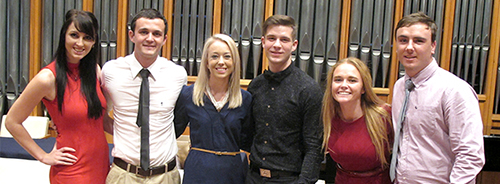 This group of Honours students in Psychology at the University of the Free State was honoured with the best postgraduate Service Learning award at the prize-giving function of the Faculty of the Humanities. From the left are Adriana de Vries, Hershel Meyerowitz, Simoné le Roux, Wijbren Nell, Melissa Taljaard, and Gerán Lordan. Photo: Marizanne Cloete.
This group of Honours students in Psychology at the University of the Free State was honoured with the best postgraduate Service Learning award at the prize-giving function of the Faculty of the Humanities. From the left are Adriana de Vries, Hershel Meyerowitz, Simoné le Roux, Wijbren Nell, Melissa Taljaard, and Gerán Lordan. Photo: Marizanne Cloete.
Horse-riding therapy helps to improve self-confidence in children, and changes their perception of themselves. It puts them in a totally new environment where they can be free of any judgement.
According to Wijbren Nell, who achieved his Honours degree in Psychology at the University of the Free State (UFS), this is the ideal therapy when working with children with disabilities. He said it was amazing to see how they developed.
He was part of a group of Honours students in Psychology who received the best postgraduate Service Learning award in the Faculty of the Humanities for their community project. In 2015, this project by Wijbren, Hershel Meyerowitz, Gerán Lordan, Melissa Taljaard, Simoné le Roux, and Adriana de Vries, was part of their module Community and Social Psychology. They were honoured at the Faculty’s prize-giving function on 15 April 2016.
Purpose of project
“Our purpose with the project was to demonstrate to the children that they could still accomplish something, despite their disabilities,” Wijbren said. The students work on a weekly basis with learners from the foundation phase of the Lettie Fouché School in Bloemfontein. Marie Olivier’s Equistria Therapeutic Development Trust serves as the site for the community project. She has a long standing partnership with the UFS.
Horse-riding and therapy
According to Wijbren, the idea was to stimulate the psychomotor functioning of the children, as well as to promote their psychological well-being. He said research has shown that there is incredible therapeutic value in horse-riding. In this specific case, it has improved the children’s self-confidence, as they may have a poor self-image as a result of their disabilities.
“At the beginning of the year, there was a girl who didn’t even want to come close to a horse, let alone getting onto the horse. We kept on trying, and, once she was on the horse, we couldn’t get her down. This was the amazing thing about the project,” said Wijbren.
Award a surprise
Wijbren said the award was a honour and surprise to his group. He was full of praise for Dr Pravani Naidoo, a lecturer in Psychology at the UFS, who coordinates the therapeutic horse riding project. “She has a tremendous passion for this project, and challenged us to think on our feet. She is a real inspiration.”